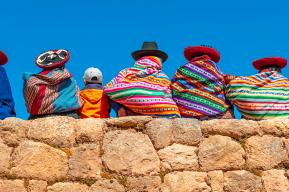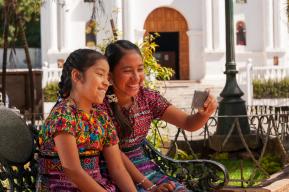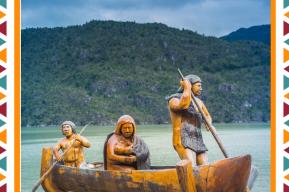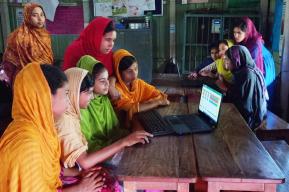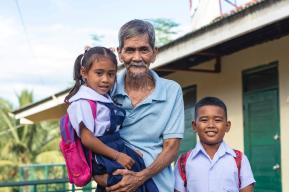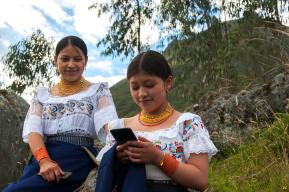News
Cutting Edge | Indigenous languages: Gateways to the world's cultural diversity

Indigenous languages: gateways to the world
Language is inseparable from our way of being, our thoughts, our feelings, our joys and much more. It is through our language that we show who we are. If our language disappears, the whole socio-cultural foundation of our community of speakers is put at risk. – Maria Virginia Haoa, about the Rapa Nui language.
As we enter the International Decade for Indigenous Languages beginning in 2022, an alarming number of languages – a majority of which are Indigenous languages – are under threat worldwide. A study published in December 2021 by the Australian National University (ANU) raises the alarm on the future of linguistic diversity, underlining that of the world’s 7,000 recognized languages – 6,000 of which are Indigenous languages – around half are currently endangered, with 1,500 particularly at risk. Against that landscape, the UNESCO Atlas of Languages, unveiled last November, provides a comprehensive online instrument to monitor linguistic diversity worldwide through multidimensional indicators, track languages in danger and promote multilingualism.
Preserving Indigenous languages – as a reservoir of diversity and an essential component of collective and individual identity – stands as an ethical imperative indissociable from respect for the dignity of the individual. When an Indigenous language is lost, not only does the knowledge accumulated by the community of its speakers fade away, but also the world’s cultural and biological diversity is jeopardized. Safeguarding the diversity of languages is crucial to protecting both cultural and biological diversity, as stated by the UNESCO 2001 Universal Declaration on Cultural Diversity, which raised cultural diversity to the level of “the common heritage of humanity”, “as necessary for humankind as biodiversity is for nature”. It is through their language that people transmit cultural values to their children and fully exercise their rights and human dignity.
Inseparable from Indigenous languages, Indigenous cultures – which embody the intrinsic relation between culture and nature – are equally threatened with extinction as put forth by the UN Permanent Forum on Indigenous Issues. The systemic discrimination suffered by many Indigenous communities across history together with the implementation of assimilationist cultural and educational policies in some countries, has hampered the safeguarding of their cultures and languages. The economic and social marginalization of Indigenous communities – 6.2% percent of the global population but 15 percent of the extreme poor – as well as their uneven access to education, and particularly to multilingual education, has disrupted the transmission and continued practice of their sets of knowledge and cultural expressions; reflecting this inequality, 47% of all Indigenous Peoples in employment have no education, compared to 17% of their non-Indigenous counterparts. Likewise, loss of access to land, territories, and natural resources – notably related to the insufficient regulation of collective ownership and use of Indigenous lands – has severely impacted Indigenous cultures and identities, which are deeply related to their natural and human environment. The major gap in life expectancy – which is some 20 years lower for Indigenous people worldwide – further testifies to the risk of cultural extinction – a situation particularly exemplified by the passing of many Indigenous elderly due to the COVID-19 pandemic over the past two years, carrying with them the knowledge they could not pass on to younger generations.
Knowledge, know-how and values conveyed by Indigenous languages and cultures are critical to set the world onto a more sustainable path. The contribution of Indigenous knowledge to climate action, biodiversity, food security, land and water management and health is undisputed worldwide and of paramount importance as we enter the final Decade of Action for the implementation of the 2030 Agenda for Sustainable Development. Speaking at the recent launch of the UNESCO Atlas of Languages, United Nations Special Rapporteur on the Rights of Indigenous Peoples, Francisco Cali Tzay, said that “Indigenous languages play an essential role in defining Indigenous relationship with Mother Earth, preserving Indigenous territory, transmitting Indigenous worldviews, science, history, and culture, and eradicating hunger by maintaining the integrity of Indigenous food systems.”

Anchoring Indigenous Peoples’ cultural rights across public policies
The creation of the UN Permanent Forum on Indigenous Issues in 2000 as an advisory body to the UN was a milestone for the recognition of Indigenous Peoples and their claims, giving particular importance to culture and education among its six core areas. Mandated to examine Indigenous issues related to economic and social development, culture, environment, education, health and human rights, the Permanent Forum provides expert advice and recommendations to the Economic and Social Council, as well as to programmes, funds and agencies of the United Nations. The Forum has issued a number of culture-related recommendations and reports over the past few years, particularly related to the documentation and repatriation of ceremonial objects and human remains, the need for tailored intellectual property frameworks to protect Indigenous knowledge and related culture-based economic opportunities, as well as the importance of traditional knowledge for resilience and disaster risk reduction.
Culture features prominently in the ILO’s 1989 Indigenous and Tribal Peoples Convention (No. 169) and inthe Declaration on the Rights of Indigenous Peoples (UNDRIP), both the main international instruments which frame Indigenous Peoples’ rights. Adopted by the UN General Assembly in 2007, pursuant to the appointment of a Special Rapporteur on the rights of Indigenous Peoples in 2001 by the Commission on Human Rights, UNDRIP is the most comprehensive statement of the rights of Indigenous Peoples ever developed, giving prominence to collective rights to a degree unprecedented in international human rights law. The UNDRIP has been translated into almost 60 languages, most of which are Indigenous.
The Declaration frames in particular the notion of Indigenous Peoples’ cultural rights, both individual and collective. Cultural rights include notably the principles of non-discrimination and cultural self-determination; the right for communities to practice and transmit their traditions and languages, as well as to protect, and repatriate as necessary, their heritage and objects, including objects of worship and human remains; the protection of intellectual property over their traditional knowledge and cultural expressions; the right not to suffer forced assimilation and to access their lands and cultural sites; as well as the right to maintain cross-border cultural cooperation within communities. Seventeen of the forty-five articles of the Declaration address Indigenous culture and how to protect and promote it. Indigenous Peoples’ relationship to their lands, territories and resources is at the heart of their identity, well-being and culture, and is the subject of the latest volume of The State of the World’s Indigenous Peoples. Culture is understood as inseparable from nature and related social practices and is a pillar of Indigenous people’s rights.
"The Asia and Pacific region has the highest proportion of Indigenous Peoples (70.5 per cent), followed by Africa (16.3 per cent), Latin America and the Caribbean (11.5 per cent), Northern America (1.6 per cent) and Europe and Central Asia (0.1 per cent)."

However, national policy frameworks have not systematically domesticated international instruments to encompass Indigenous Peoples’ cultural rights, including multilingualism. For example, only about 15 per cent of Indigenous Peoples live in the 23 countries that have ratified the ILO Indigenous and Tribal Peoples Convention (No. 169), meaning that a majority of Indigenous Peoples continue to fall outside the protection it provides. The constitutional recognition of Indigenous Peoples’ linguistic and cultural rights is uneven, although strong institutional models do exist. In Mexico, Indigenous Peoples’ cultural and linguistic rights are explicitly recognized not only in the national constitution but also in the regional constitutions of 28 of the 32 federal states. Likewise, the constitutions of the Plurinational State of Bolivia (2009) and Ecuador (2008) do not just recognize Indigenous Peoples but aim to build a State based on the values of all nations present in its territory. They introduce several Indigenous principles, such as “sumak kawsay” (good way of living, Ecuador) and the Bolivian constitution recognises 36 official Indigenous languages. Peru institutionalized to a significant extent the participation of Indigenous Peoples in public policy decision-making, including cultural policies, through the General Consultation Law. In Europe, the Sami people are part of the few Indigenous Peoples that have their own political body of representation and self-management before the Governments of Sweden, Finland and Norway, by means of their parliament, including cultural policies.
The Asia and Pacific region has the highest proportion of Indigenous Peoples (70.5 per cent), followed by Africa (16.3 per cent), Latin America and the Caribbean (11.5 per cent), Northern America (1.6 per cent) and Europe and Central Asia (0.1 per cent). Implementing the ILO Indigenous and Tribal Peoples Convention No. 169: Towards an inclusive, sustainable and just future (2020)
In many countries, laws and policies addressing Indigenous Peoples’ cultures and languages are fragmented over several institutions, meaning that there is little impact for and limited participation of Indigenous Peoples. Just this year, Canada adopted the United Nations Declaration on the Rights of Indigenous Peoples Act as “as a key step in renewing the Government of Canada’s relationship with Indigenous Peoples.” Some Latin American countries have recently strengthened their institutional model such as the Mexican National Institute of Indigenous Peoples, established in 2018, and Chile’s has presented a bill to establish a Ministry. Meanwhile, Uganda made steps forward through the recently-enacted Code of Cultural Policies on sovereign rights.
Language and traditional knowledge: inextricably linked
Despite some incremental progress in realising Indigenous Peoples’ cultural rights, a 2012 study by the Expert Mechanism on the Rights of Indigenous Peoples – which provides the Human Rights Council with expertise and advice on the rights of Indigenous Peoples – lamented the “dismal state of Indigenous Peoples’ languages”, citing, for example, the loss or near extinction of some 205 of the 250 languages that existed in Australia prior to European settlement 300 years ago. It is estimated that one of the world’s languages disappears every two weeks, which means a whole worldview and an entire system of knowledge, practices and know-how vanishes. Indigenous Peoples’ languages are usually spoken by a minority of individuals within a country and have been, historically and today, subject to assimilationist policies. Often there is a close relationship between Indigenous Peoples’ cultures and languages and their physical and spiritual environments. Furthermore, urbanization resulting from economic pressures or forced displacement can separate Indigenous Peoples from the lands where their languages and cultures are practiced. Whilst some examples exist - such as the 1987 New Zealand Maori Language Act, the 2011 Moroccan Constitution which recognises the Tamazight language as an official language alongside Arabic, the Canadian 2019 Indigenous Languages Act and Peru’s 2021 National Policy on Native Languages, Oral Tradition and Interculturality to 2040 which enshrine the notion of intercultural bilingual education – Indigenous languages are often not officially recognized in legislation and policy, or insufficient funding is available for language revitalization. The use of mainstream or national languages in education systems also hinders the transmission of Indigenous languages in schools.
The UNESCO-led International Decade for Indigenous Languages is an opportunity to step up mainstreaming cultural and linguistic diversity into sustainable development efforts. Following the advances made during the2019 International Year for Indigenous Languages, the UN General Assembly has invited UNESCO – building on its multidisciplinary mandate – to lead this decade of action, in cooperation with the UN system, particularly the United Nations Department of Economic and Social Affairs and the Office of High Commissioner for Human Rights. The Organization’s work is guided by its 2017 Policy on Engaging with Indigenous Peoples that aligns with UNDRIP. The decade aims to ensure Indigenous Peoples’ right to preserve, revitalize and promote their languages – notably through policy development and multistakeholder dialogue – but also to enhance the transmission and safeguarding of Indigenous cultures. The strategic directions, thematic considerations and implementation guidelines for the decade are reflected in the Los Pinos Declaration, endorsed in February 2020 in Mexico City upon the impetus of Mexico, and in the Global Action Plan.

Indigenous languages and related knowledge are intrinsically linked to the preservation of biological and cultural diversity, as they are conducive to a systemic approach to culture and nature. Many Indigenous worldviews transcend the distinctions between science and culture, or eschew the boundaries between cultural heritage, natural heritage and intangible cultural heritage. For example, in the Lakota language of North America, the word “Mitákuye Oyás’iŋ” means “all is related” or “all my relatives” – both human and non-human. These knowledge systems, on par with scientific disciplines, are critical to sustainable development. Echoing this recognition, the UNESCO Local and Indigenous Knowledge Programme has worked for the past 20 years to integrate such knowledge into international contemporary science-policy-society fora on issues such as biodiversity, climate change and disaster preparedness. Likewise, the 2003 UNESCO Convention for the Safeguarding of the Intangible Cultural Heritage recognizes the rich diversity of living heritage, and the contribution of this heritage to the vitality, strength and wellbeing of communities, also allowing Indigenous Peoples to shape the international heritage discourse and to have their experiences and needs recognized.
“The major influence on the sorry state of their languages is the fact that indigenous peoples are threatened themselves,” says Minnie Degawan (Igorot, Philippines)
Having a say: Indigenous languages in the classroom and cultural spaces
Education is at the heart of ensuring the preservation of Indigenous languages and traditional knowledge, as well as being a fundamental human right. Indigenous Peoples are entitled to rights related to education as enshrined in the UNDRIP, the 1989 UN Convention of the Rights of the Child and the UNESCO 1960 Convention against Discrimination in Education. The development of bilingual intercultural education programmes or training manuals is essential to allow systemic transmission of knowledge and safeguard Indigenous cultures. The importance of multicultural and multilingual education is expected to be further underlined as part of the ongoing revision of the UNESCO 1974 Recommendation concerning Education for International Understanding, Co-operation and Peace and Education relating to Human Rights and Fundamental Freedoms. Research has demonstrated that teaching children Indigenous knowledge in traditional ways conserves the communities’ cultures, reduces school drop-out rates, helps with disciplinary problems and leads to economic growth. Indigenous education takes a holistic approach to ensuring that children can adapt and respond to the challenges and demands of the world today.
UNESCO promotes the right to education and particularly education in mother tongue, including Indigenous languages, as well asthe intergenerational transmission of intangible cultural heritage through formal and non-formal education. The Expert Mechanism on the Rights of Indigenous Peoples states that quality education for Indigenous Peoples means “education that is well resourced, culturally sensitive, respectful of heritage and that takes into account history, cultural security and integrity, encompasses human rights, community and individual development.” This has unfortunately rarely been the case. Positive examples include Paraguay’s 1994 national policy of bilingual teaching, and language nests – which operate like a nursery, with older community members providing childcare while speaking their language. Other examples can be found in New Zealand, Canada, the United States of America, Australia, Finland, and the Russian Federation. In Nicaragua, UNESCO supported Mayangna communities in the Bosawás Biosphere Reserve, using intercultural bilingual education for Indigenous Peoples to adapt curriculum to their cultural context by developing classroom materials in their language and teaching their knowledge of the environment while also building social and cultural capital. The Xtaxkgakget Makgkaxtlawana: the Centre for Indigenous Arts of the Totonac people of Veracruz, Mexico passes on traditional knowledge of pottery, textiles, paintings, art of healing, traditional dance, music, theatre and cuisine, in the Totonec language.

Museums are also key spaces for education and dialogue, both for actively engaging Indigenous Peoples in cultural institutions and for displaying Indigenous artefacts, with a view to promote an appreciation of Indigenous cultural heritage. For example, the National Museum of the American Indian displays original copies of treaties signed between the United States of America and Indigenous Peoples, whilst he Sámi Museum Siida, Finland, is an example of how museums that are managed by or in close collaboration with Indigenous Peoples play a key role in the safeguarding and transmission of cultural heritage. UNESCO is also supporting the creation of an underwater cultural heritage museum in Titicaca Lake, located in the Andes mountains between Bolivia and Peru, in benefit and cooperation with local Indigenous populations, that unveils civilizations whose vestiges are now underwater.

Museums are increasingly called to be on the frontline in tackling misappropriation of indigenous cultural heritage. Unfortunately, several museums, both private and public, hold and display indigenous cultural heritage without the consent of the peoples concerned. The UNESCO 2015 Recommendation concerning the protection and promotion of Museums and collections, their diversity and their Role in society urges Member states, when appropriate, to engage in dialogues concerning the management and possible return of heritage which can be initiated between Indigenous Peoples and museums in possession of collections relating to them. The UNESCO 1970 Convention on the Means of Prohibiting and Preventing the Illicit Import, Export and Transfer of Ownership of Cultural Property makes reference to "tribal and Indigenous Peoples" and the 1995 UNIDROIT Convention on Stolen or Illegally Exported Cultural Objects reinforces these provisions. In reality, it is often difficult for Indigenous Peoples to receive protection and reparation when their cultural heritage, particularly intangible heritage, is misappropriated, as noted by the Expert Mechanism. Yet in 2020 the National Museum of Finland announced the return of 28 funeral objects and human remains to four Indigenous communities in the United States under the aegis of the UNESCO 1970 Convention.
Overall, engaging Indigenous Peoples in the cultural sector in more systemic ways is critical in shaping a more comprehensive narrative and build inclusive societies. Efforts are being undertaken to engage Indigenous communities in the management of cultural sites and museums and, more broadly, the design and implementation of cultural policies, as well as to ensure equitable representation of Indigenous cultures through mainstream cultural industries. For example, Mexican actress and UNESCO Goodwill Ambassador for Indigenous Peoples, Yalitza Aparicio, won great acclaim for her role in Alfonso Cuarón’s film Roma. Some Indigenous groups are becoming more vocal, stressing that their cultures should not be viewed as relics of the past but instead be understood as living and dynamic.
A number of initiatives at national or local level are intended to revitalize indigenous cultural practices. As part of the EU funded initiative on Governance for Culture in Developing Countries, within the UNESCO 2005 Convention for the Protection and Promotion of the Diversity of Cultural Expressions, a project is being developed by Mexico to adapt public policies to support Indigenous and Community Media and incorporate indigenous content into public and commercial media. UNESCO’s International Fund for Cultural Diversity has financed projects to support Indigenous Peoples’ creative expressions, from training youth in the steel pan art in Saint Lucia and budding filmmakers in Guatemala, to supporting musicians from Namibia’s San community to access global markets and strengthening Indigenous e-books in Brazil. Furthermore, media and information technology can provide effective tools for the revitalisation of Indigenous languages. The Google search engine in the Māori language of New Zealand and the online Cree Dictionary project in Canada are among the positive examples. Recognizing the importance of community radio, UNESCO’s International Programme for the Development of Communication (IPDC) has funded approximately thirty Indigenous people’s projects, since 2000. In addition, two year budget period, UNESCO supports, on average, fifty community radio stations.
Earth’s unsung environmental stewards
Indigenous Peoples are on the front lines of climate change, as well as its counterpart, biodiversity loss, as its irreparable damage to the natural environment has a devastating impact on their way of life. Both issues are alarming, with a 2021 Intergovernmental Panel on Climate Change (IPCC) report sounding a “code red for humanity” and a 2019 UNESCO Intergovernmental Science-Policy Platform on Biodiversity and Ecosystem Services (IPBES) report signalling that around 1 million animal and plant species are now threatened with extinction, many within decades. Indigenous Peoples, in particular those who live on small islands, in deserts or in the Arctic region, have been severely affected by climate change. The 2015 Paris Agreement recognises that climate action must “be based on and guided by […] knowledge of Indigenous Peoples and local knowledge systems” whilst the 1992 Convention on Biological Diversity calls on States Parties to “respect, preserve and maintain knowledge, innovations and practices of Indigenous and local communities embodying traditional lifestyles relevant for the conservation and sustainable use of biological diversity”. There is a recognition, however, that implementation is patchy.
Traditional knowledge understood as a living body of knowledge that is developed, sustained and passed on within a community, forms an integral part of Indigenous cultural and spiritual identity. It encompasses knowhow, skills, innovations and practices, as well as traditional cultural expressions, including dances, songs, handicrafts, designs, ceremonies, tales.

The nomadic Fulani pastoralists in the Sahel region of Chad observe the weather and flowering plants to predict the rains and to know where to move with their herds, whilst for centuries, Indigenous Andean farmers have successfully forecasted the forthcoming rainy season and El Niño conditions by observing the Pleiades star cluster. Traditional knowledge continues to innovate and adapt – the hallmarks of vibrant, living cultures. For example, fishermen in Vanuatu have incorporated nylon nets into traditional fishing techniques whilst traditional gothi tree canoes of fishermen in Solomon Islands now use a motor. Meanwhile, the Siã Shanenawa people in the Brazilian Amazon are using drones and artificial intelligence to tackle deforestation.
Indigenous Peoples are often better positioned than traditional science to observe and understand ecosystems and provide information on local biodiversity and climatic change. For example, the Vanua Navakavu in the Fiji Islands documented the vernacular names for over 1,000 species over a 50-year period. Since 1999 Mongolian pastoralists observing the “torgnii hee boroo” (silk embroidery rains) have reported the degradation of pastures due to changes in rain quality and distribution where scientific data show no significant change for the same area and period. Tongan farmers use their traditional calendar to decide when to plant and harvest and their observations of weather change are crucial for understanding climate change impacts and policy responses. In Siberia, Nenets reindeer herders have collaborated with NASA to study weather conditions: NASA provided satellite imagery, while herders provided observations of weather and pasture conditions. The ancestral voyaging knowledge of the Pacific and tradition fish weirs (stone-wall traps that rely on tides) are also being mobilized for ocean biodiversity and climate change monitoring, particularly in the context of the UN Decade for Ocean Science, whose implementation is entrusted to UNESCO. To bridge the Decades for Ocean Science and Indigenous Languages, the Pacific Community (SPC) advocates for the role of Indigenous languages in transmitting ocean knowledge as part of the Pacific Community Centre for Ocean Science – a knowledge hub on ocean science for governments and communities – and through policy advice to the Office of the Pacific Ocean Commissioner.
Indigenous Peoples own, occupy, or use a quarter of the world’s surface area, and it is estimated that at least 1.65 billion Indigenous Peoples and members of local communities live in important biodiversity conservation areas, home to 80% of the world’s remaining biodiversity. A report from the Food and Agriculture Organization (FAO) and the Fund for the Development of the Indigenous Peoples of Latin America and the Caribbean (FILAC) showed that about 45% of the intact forests in the Amazon Basin were in Indigenous territories. Within the first draft of the Convention on Biological Diversity’s (CBD) Post-2020 Global Biodiversity Framework, human rights groups emphasize that the target to safeguard 30% of the world’s biodiversity by 2030 should not lead to the displacement of local communities.

There is an expanding body of knowledge that demonstrates the contributions of Indigenous Peoples in managing land. The Dayek people of Borneo, Indonesia and the Karen of Thailand have used traditional rotational farming practices to regeneratelarge tracts of forest affected by commercial logging. A 2017 joint UNESCO publication Knowing our Lands and Resources also documents examples of Indigenous management of land in Asia, including the begnas ritual system of Sagada, Northern Philippines, forest conservation by the Kaani Indigenous community of Kanyakumari forests, India, Indigenous knowledge of Qanats (aqueducts) in the Tangsayad-Sabzkouh biosphere reserve, Iran and pastureland management in the Kailash sacred landscape, Nepal. A ruling by Panama’s Supreme Court of Justice in November 2020 led to the official creation of a comarca, or protected Indigenous territory, for the Naso Tjër Di people, a decision resting in part on evidence of the role that Indigenous groups play in protecting the environment. The 2018 UNESCO publication Indigenous knowledge and climate change documents other experiences.
Indigenous communities are increasingly central in the sustainable management of natural, cultural or mixed World Heritage sites. The inclusion of cultural landscapes as a new category of World Heritage properties back in 1992 expanded conceptions of heritage, as illustrated by the renomination of New Zealand’s “Tongariro National Park” in 1993 and Australia’s “Uluṟu-Kata Tjuṯa National Park” in 1994 for their cultural values, according to the wishes of the traditional Aboriginal owners. In 2018, UNESCO launched the International Indigenous Peoples’ Forum on World Heritage to strengthen dialogue with Indigenous Peoples and ensure policies respect their rights. Respect for Indigenous people’s rights is increasingly embedded in the management plans of World Heritage sites, such as the site of the Megalithic Circles in Wanar, Senegal or the Okapi Wildlife Reserve, Democratic Republic of the Congo. A recent partnership was also enacted at France’s Lagoons of New Caledonia World Heritage site as part of the Resilient Reefs Initiative, in which the customaries of eight chiefdoms across the island committed to using sustainable methods of turtle fishing in line with their customs but preserving the species threatened with extinction.
Traditional knowledge also contributes to the resilience – particularly food security – of Indigenous communities in the face of environmental degradation, as documented in a 2012 UNESCO study Weathering Uncertainty: Traditional Knowledge for Climate Change Assessment and Adaptation. The publication showed that local and indigenous farmers in Bolivia, China and Kenya who, over the centuries, have maintained different varieties of crops were able to switch to more wind-, pest- and drought-resistant varieties when the impacts from climate change began affecting their yields. The FAO Globally Important Agricultural Heritage Systems promote the importance of traditional management and use of resources to ensure food and livelihood security in the face of climatic variability and natural hazards. Andean agriculture in Peru is an interesting example of the adaptation and knowledge of farmers to their environment for more than 5000 years, intrinsically linked to their strong social organization with their own norms and cultural rituals as the tribute to the “Pachamama” (mother earth) and the “apus” (local gods represented by hills, mountains, rivers and atmospheric phenomena).

The World Health Organization (WHO) as well as international health studies are increasingly recognizing traditional health care and its contribution to SDG 3 (health). During the pandemic, Indigenous communities, many without access to health centres, have addressed COVID-19 symptoms with traditional medicine. In Latin America, for example, Indigenous healers often combine an extensive pharmacopeia with ritual practices to jointly restore bodily and spiritual balance, as noted by the UNESCO International Bioethics Committee in a 2013 report on the ethics of traditional medicine. The Yanomamï of Venezuela, have names for 50 types of bees that provide honey for food or medicine. The Jambi Huasi (Health House) in Otavalo, Ecuador, provides such services in the Quechua language, whilst the pharmaceutical knowledge of some 980 species of the Kallawaya itinerant male healers who practice ancestral medical techniques in Bolivia is one of the richest in the world. The inscription on the UNESCO Lists of Intangible Cultural Heritage of yoga (India), Taijiquan (China), the acupuncture and moxibustion of traditional Chinese medicine or the traditions and practices associated with the Kayas (Kenya) also testify to a growing recognition of traditional health care systems.
Securing intellectual property frameworks, both individual and collective, remains critical to avoid misuse or misappropriation of Indigenous knowledge, as testified by the increasing records of exploitation of such knowledge without the consent of or benefit to the knowledge bearers, notably by the tourism, fashion, food or pharmaceutical industries. This issue was already enshrined in the UNDRIP, which states that Indigenous Peoples have the right to maintain, control, protect and develop their intellectual property over cultural heritage, traditional knowledge, and traditional cultural expressions. The Intergovernmental Committee on Intellectual Property and Genetic Resources, Traditional Knowledge and Folklore, established in 2000 by the World Intellectual Property Organization (WIPO), has served as a forum to discuss intellectual property issues arising in the context of access to genetic resources and benefit-sharing, and protection of traditional knowledge and traditional cultural expressions; a related international legal instrument is currently being negotiated. However, while this legal instrument does recognize Indigenous intellectual property, it focuses on individual intellectual property and product-related patents, rather than community-owned collective property. Tailored regulatory frameworks are needed to encompass the specificity of Indigenous cultures and tackle misappropriation. The UNESCO 2003 Convention for the Safeguarding of Intangible Cultural Heritage, whose concepts and operational tools focus on bearers and communities, explicitly promotes the communities’ ownership of their cultural expressions.
Indigenous Peoples – as repositories of knowledge, practices, worldviews, wisdom, and heritage – play a fundamental role in sustainable development as guardians of vast swathes of biological and cultural diversity. But they can only do so when their rights are protected. The UNDRIP calls for Indigenous Peoples’ participation in all decisions that will affect their lives through their “free, prior and informed consent”, for States to provide effective measures to combat and eliminate discrimination against Indigenous Peoples, as well as their right to remain distinct and to pursue their own visions of economic and social development, thus safeguarding their cultures.

The protection and promotion of Indigenous Peoples’ languages and cultures requires States to fully engage them, and recognize them in their constitutions, laws and policies. At the national level, addressing cultural policies for the benefit of and together with Indigenous Peoples requires a comprehensive and multi-layered approach, encompassing a broad spectrum of dimensions, from the preservation and use of Indigenous languages to the safeguarding of living heritage practices, the protection of Indigenous cultural heritage (including territories and artefacts) to the promotion of Indigenous cultural expressions. While some regions have made progress, recognising cultural and ethnic diversity within countries, including through harmonizing legal and institutional frameworks, policies are still lagging behind to adequately address policy concerns with regard to the safeguarding of Indigenous cultures, which is detrimental to the sustainable development of these communities. Participatory approaches should be developed to support cultural self-determination, notably by including Indigenous practices, protocols and ethical standards in heritage safeguarding mechanisms, supporting participatory inventories of cultural heritage, as well as cross-border cooperation within the same community.
There is an urgent need to enhance the intergenerational transmission of Indigenous knowledge, alongside and within formal education through more systemic educational systems and instruments. Efforts are being made to bring Indigenous language and knowledge into school curricula, as well as to move learning back into the community, thus reaffirming the importance of transmission. Effectively including Indigenous Peoples’ knowledge, holistic worldviews and cultures in the development of education policies, programmes, projects and practices and promoting their perspectives, would provide meaningful learning opportunities that are equally accessible and appropriate for all Indigenous people, as advocated in the recently-launched UNESCO Futures of Education report. Particular attention should be given to priority groups that are critical for transmission, particularly women, youth and the elderly.
Indigenous Peoples have expressed concerns over existing international intellectual property mechanisms as being inadequate to protect Indigenous knowledge and cultural expressions from over-commercialization, misuse and appropriation, including in the digital environment. Concerns identified include the fact that intellectual property systems are focused on protecting the intellectual property of individuals rather than collectives, the view that intellectual property as alienable, and that they are not consistent with Indigenous Peoples’ customary laws and policies related to their knowledge. An expanded view of intellectual property protection could make it possible to protect indigenous cultures against misappropriation and enable communities to control and benefit collectively from its commercial exploitation.
UNESCO Culture Conventions should be further harnessed to support the effective recognition and contribution of Indigenous cultures and languages within their national legal and policy frameworks. As recommended at the webinar on Cultural policies and Indigenous Peoples organised on 30 November 2021 by UNESCO, Culture Conventions should provide a platform to enhance dialogue between Member States and Indigenous Peoples, on the example of the International Indigenous Peoples’ Forum on World Heritage, established in 2018. Specific provisions focusing on Indigenous peoples' participation, as already introduced in the 1972 and 2003 UNESCO Conventions, may also be strengthened within other Conventions. The impact of the Culture Conventions on Indigenous Peoples and cultures should be further assessed, notably as regards intellectual property, forced displacement, systematic consultation and participation.
The International Decade of Indigenous Languages is also the occasion to strengthen UNESCO’s work, to reinforce the rights of Indigenous Peoples, particularly cultural rights. Thirty years after being awarded the Nobel Peace Prize, the words of K'iche' Maya (Guatemala) human rights activist, Rigoberta Menchú continue to ring true: “Peace cannot exist without justice, justice cannot exist without fairness, fairness cannot exist without development, development cannot exist without democracy, democracy cannot exist without respect for the identity and worth of cultures and peoples.” This includes the precious identity and rich cultures of all Indigenous Peoples.




